| Back Number | No.23 2005/08/31 | |||
| News | The August EXPO 2005 Message Event held |  |
||
| Pavilions | UK Pavilion (Global Common 4) International Red Cross & Red Crescent Pavilion (Global Common 2) United Nations Pavilion (Global Common 2) Poland Pavilion (Global Common 4) |
|||
| Column | New Energy and EXPO 2005 Aichi, Japan | |||
|
The EXPO 2005 Message Events themed “The Creation of Sustainable Society” by learning from Nature’s Wisdom was held on August 27 and 28. The monthly event is held to exchange diverse global wisdom and to transmit it to the world from Japan and consists of two activities: the “EXPO 2005 International Forums” and “EXPO 2005 International Workshops.” |
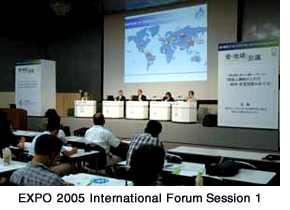 The EXPO 2005 International Forums is the first relay symposium in EXPO history in which the same theme will be considered by world intellectuals. It started with the opening forum held on March 27 and 28 and has been held every month since. The recent forum was the sixth.
The EXPO 2005 International Forums is the first relay symposium in EXPO history in which the same theme will be considered by world intellectuals. It started with the opening forum held on March 27 and 28 and has been held every month since. The recent forum was the sixth.The EXPO 2005 International Forum event held in August was entitled International Symposium on Climate Change, “Economic and Industrial Development in Harmony with the Environment.” Held on the afternoon of August 27 in Nagoya, it consisted of three sessions with Mitsutsune Yamaguchi, Professor of Economics, Teikyo University/Japan, as moderator. Active discussions took place during the sessions. The theme of Session 1 was “Promoting development and diffusion of innovative technologies.” Four panelists - Dr. Yoichi Kaya (Director-General of the Research Institute of Innovative Technology for the Earth (RITE)/Japan), Dr. Nebojša Nakicenovic (International Institute for Applied Systems Analysis (IIASA)/Russia), Dr. Robert K. Dixon (Council on Environmental Quality, Executive Office of the President/US) and Dr. Peter J. G. Pearson (Imperial College/UK) - participated in the session, conducting active discussions regarding their thoughts and measures regarding the efficient development and diffusion of innovative technologies. Actual examples, including the history of technical innovation in France, the US and the UK and current policies were cited during the discussions. Session 2 was themed “Facilitating technology transfer to developing countries.” Three panelists - Katsuhiko Kotani (Chief Representative in China and General Manager of the Beijing Office, Nippon Steel Corporation/Japan), Taishi Sugiyama (Leader of Climate Policy Project, Central Research Institute of Electric Power Industry (CRIEPI)/Japan) and Dr. Ajay Mathur (President of Senergy Global Ltd./India) - participated in the session. In this session, examination of the transfer of environmentally-sound technologies to developing countries was made from various angles, using India and China as examples. |
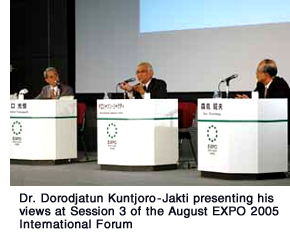 Session 3 was “Striking a balance between environment and economy.” With Prof. Akio Morishima (Chair of the Board of Directors/President, the Institute for Global Environmental Strategies (IGES)/Japan) and Dr. Dorodjatun Kuntjoro-Jakti (Prof., University of Indonesia; Former Minister Coordinator for Economic Affairs/Indonesia) as panelists, discussion was held to make general conclusions on the basis of the discussions in Sessions 1 and 2. Prof. Morishima proposed, from an economic perspective, the roles that should be played in technological development by the private sector, governments and international society. Dr. Dorodjatun Kuntjoro-Jakti raised issues regarding the various realities of developing countries, such as poverty, which come before technology transfer.
Session 3 was “Striking a balance between environment and economy.” With Prof. Akio Morishima (Chair of the Board of Directors/President, the Institute for Global Environmental Strategies (IGES)/Japan) and Dr. Dorodjatun Kuntjoro-Jakti (Prof., University of Indonesia; Former Minister Coordinator for Economic Affairs/Indonesia) as panelists, discussion was held to make general conclusions on the basis of the discussions in Sessions 1 and 2. Prof. Morishima proposed, from an economic perspective, the roles that should be played in technological development by the private sector, governments and international society. Dr. Dorodjatun Kuntjoro-Jakti raised issues regarding the various realities of developing countries, such as poverty, which come before technology transfer.On the evening of the following day, August 28, the “Bridge Eternal” ~Neo-Balkan Concert~ was held at EXPO Dome of EXPO 2005’s Nagakute Area. The theme was “Creation of Sustainable Society ~Harmony and Coexistence~.” Two individuals and two groups representing Croatia, Serbia and Montenegro, Bosnia and Herzegovina, and Macedonia, which are countries which had gained independence from what was formerly Yugoslavia, participated in the concert. The artists, who represent the Balkan countries that are aiming to recover from the war and destruction that took place during the fall of Yugoslavia and create a new society, enthusiastically performed 11 songs in roughly an hour and a half. They presented their message of harmony and coexistence through music. The performances of the artists - including Putokazi, a choral ensemble consisting of seven women who incorporated dance movements to traditional Croatian choral singing - that fused traditional Balkan music with contemporary sounds entranced the audience. |
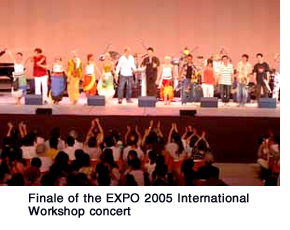 At the end of the concert, students from the Nagoya University of Arts, who worked together to create an original sound expressive of the EXPO’s “Nature’s Wisdom” theme, joined in with the Balkan performers. There was great applause from the audience for the amazing session in which all became one.
At the end of the concert, students from the Nagoya University of Arts, who worked together to create an original sound expressive of the EXPO’s “Nature’s Wisdom” theme, joined in with the Balkan performers. There was great applause from the audience for the amazing session in which all became one.The final Message Event will be held on September 21. The closing forum of the EXPO 2005 International Forums will be “Towards the Creation of Sustainable Society,” and the closing session of the EXPO 2005 International Workshops will be “Message to the Future,” scheduled to be held at EXPO Dome. |
![]()
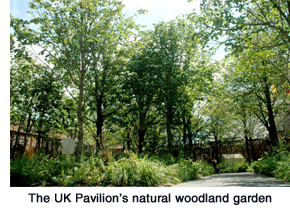 The theme of the UK Pavilion is “Planet of Blessing and Budding.” One of the highlights is the UK Pavilion garden, a woodland garden filled with 40 lime trees, British ferns and seasonal flowers. Of the many pavilions of foreign countries at EXPO 2005 Aichi, Japan, the UK Pavilion is the only one to have such a garden - one that accounts for half of its site. The garden also doubles as an outdoor gallery; it is the setting for works themed on global environmental issues created by contemporary British artists.
The theme of the UK Pavilion is “Planet of Blessing and Budding.” One of the highlights is the UK Pavilion garden, a woodland garden filled with 40 lime trees, British ferns and seasonal flowers. Of the many pavilions of foreign countries at EXPO 2005 Aichi, Japan, the UK Pavilion is the only one to have such a garden - one that accounts for half of its site. The garden also doubles as an outdoor gallery; it is the setting for works themed on global environmental issues created by contemporary British artists.After passing through the garden, visitors entering the pavilion structure find themselves in a completely different, darkened setting with beautiful lighting. This is the Innovation Zone featuring seven innovative projects or products, each of which has been developed after being inspired by nature. The highly specialized projects and products are introduced using video and interactive media, providing visitors with an entertaining experience as they come into contact with cutting-edge technology. Of special interest are the Eden Project, which is a series of conservatories whose construction has been inspired by the honeycombs of bees; and the TidEl system, which generates power using the ebb and flow of the tides. These two technologies were selected for Global 100 Eco-Tech Awards prizes in June by the Japan Association for the 2005 World Exposition. Products, such as the Ultracane, an electronic mobility aid that helps vision-impaired people find their way around by utilizing ultrasonic signals, used by bats to fly around in the dark, are also on display. Visitors to the UK Pavilion cannot help but appreciate the blessings of nature while also being amazed by the array of state-of-the-art technologies inspired by nature. The UK pavilion was also awarded the Nature’s Wisdom Award bronze prize for its content and design by the Japan Association for the 2005 World Exposition. |
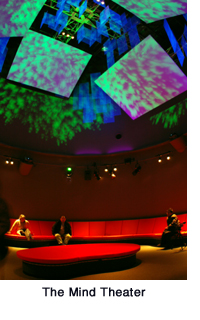 Long queues form outside the International Red Cross & Red Crescent Pavilion every day shortly after its 9:00am opening. More than 40,000 written messages have been left here by visitors to the pavilion, filling the walls of the Message Zone. Written are words such as, “I was greatly stirred from the bottom of my heart, and I could not stop crying,” and “What have I been doing up to now? This has made me want to live my life to the best of my ability.” The visitors have been moved by a 7-minute movie shown at the pavilion’s Mind Theater.
Long queues form outside the International Red Cross & Red Crescent Pavilion every day shortly after its 9:00am opening. More than 40,000 written messages have been left here by visitors to the pavilion, filling the walls of the Message Zone. Written are words such as, “I was greatly stirred from the bottom of my heart, and I could not stop crying,” and “What have I been doing up to now? This has made me want to live my life to the best of my ability.” The visitors have been moved by a 7-minute movie shown at the pavilion’s Mind Theater.The short movie shows - to “Tagatame (For whom?),” a song written and composed by leading Japanese musician Kazutoshi Sakurai of Mr. Children -- people around the world crossing the boundaries of race, nationality and religion to rescue those suffering from wars, natural disasters and diseases. Audiences lie down on sofas and watch the movie on four screens set up overhead. The content of the footage shown is not necessarily that seen by people for the first time. However, it seems to create a deeply stirring experience which moves people when it is shown, together with the words and music of “Tagatame,” at this theater. Other messages written at the Message Zone included, “The smiles on the faces of children were very beautiful,” and “There are many dilemmas and worries that I face, but they now seem so trivial.” Meanwhile, a 15 year old girl wrote, “Though I am still a child myself, I felt for the first that I want to save the children.” Each and every one of these messages further resonates with the hearts of visitors to this pavilion. The Japanese Red Cross Society was founded by Tsunetami Sano who visited the Red Cross Pavilion at the Exposition Universelle de Paris of 1867. What now will be born from the people who have visited this pavilion at EXPO 2005 Aichi, Japan? |
| The theme of the United Nations Pavilion is “Celebrating Diversity.” This pavilion provides visitors an understanding of the various activities of the 38 organizations, funds and programs of the UN who participated in the UN Pavilion. Visitors are first greeted by a video message from Kofi Annan, Secretary-General of the United Nations. They then head towards a photo exhibit that covers the entire south wall of the pavilion. On display here are photographs that received awards at a photo contest organized by the United Nations Environment Programme (UNEP) supported by Canon. They are all striking photos that each brings to light realities faced by the world, such as environmental destruction, poverty, conflict and natural disaster. |
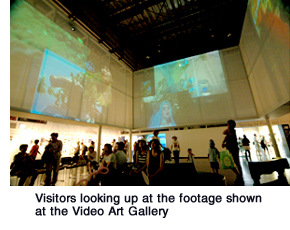 At the center of the UN Pavilion is the Video Art Gallery, a space surrounded by four white screens overhead on which are shown, one after another, scenes such as the diversity of the world’s flora and fauna, the smiles of people wearing diverse ethnic costumes in their festivals, activities around the world conducted by the United Nations, and so on. It communicates the meaning behind the pavilion theme of “Celebrating Diversity.”
At the center of the UN Pavilion is the Video Art Gallery, a space surrounded by four white screens overhead on which are shown, one after another, scenes such as the diversity of the world’s flora and fauna, the smiles of people wearing diverse ethnic costumes in their festivals, activities around the world conducted by the United Nations, and so on. It communicates the meaning behind the pavilion theme of “Celebrating Diversity.”A feature of this pavilion is that the UN family, its organizations and so on, sequentially organize exhibits and events here. The current exhibit is one that has been organized by the United Nations Educational, Scientific and Cultural Organization (UNESCO) and the United Nations Environment Programme (UNEP) and is entitled, “The Great Apes Survival Project.” It appeals the protection of the great apes, such as gorillas and chimpanzees, from various aspects, including the showing of related footage, poster exhibits and picture-story performances. From September 4, the theme of the exhibit to be organized by the United Nations Development Programme (UNDP) and the United Nations Volunteers (UNV) will be “Biodiversity, Equator Initiative and the MDGs.” We recommend that those interested in such themes visit the United Nations Pavilion during the relevant periods. |
| The theme of the Poland Pavilion, which has an eye-catching, intriguing exterior that looks as if it is wrapped in a basket made of tree bark, is “See the Beauty.” In the pavilion, visitors will first enter and seat themselves in a space that becomes filled with music and films. This is Chopin Hall, which is surrounded on three sides by projection screens, with audience seating set up on an incline. Beautiful footage pass before audiences one after another, including scenes of a large herd of horses running across a prairie towards them, river boat tours where people will feel as if they will be covered with its sprays of water, and the squares and age-old cityscapes of Gdansk, Krakow and Warsaw. They blend with delicate music - including piano pieces by Chopin - and invite audiences into the fascinating world of Poland. |
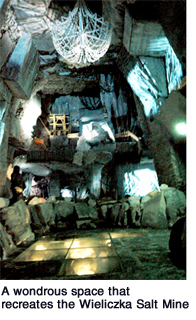 Next, pavilion visitors will take an elevator to a lower floor. When the door opens, they will find themselves in a dark-lit mysterious space. This is a recreation of the Wieliczka Salt Mine located in the vicinity of Krakow, an ancient city in southern Poland. At 327 meters deep and a total of 300 kilometers in length, the still operational salt mine is the largest mine in the world that dates back to the 13th century. Old wooden boards that supported the wall of the mine shafts and giant blocks of salt, all brought from Poland, give visitors the illusion that they are in the actual rock-salt mine.
Next, pavilion visitors will take an elevator to a lower floor. When the door opens, they will find themselves in a dark-lit mysterious space. This is a recreation of the Wieliczka Salt Mine located in the vicinity of Krakow, an ancient city in southern Poland. At 327 meters deep and a total of 300 kilometers in length, the still operational salt mine is the largest mine in the world that dates back to the 13th century. Old wooden boards that supported the wall of the mine shafts and giant blocks of salt, all brought from Poland, give visitors the illusion that they are in the actual rock-salt mine.The Wieliczka Salt Mine, inscribed on the World Heritage List, is also known for beautiful salt sculptures. Visitors to the Poland Pavilion will be able to get a glimpse of its splendor, from sculptures of a king, queen and the Virgin Mary made of black rock salt to a crystal-clear chandelier on the ceiling. Also available at the Poland Pavilion is a taste of the country’s traditional cuisine and vodka as well as jewelry that combines amber from the Baltic Sea with gold and silver works. The Poland Pavilion enables visitors to enjoy encountering the various wonderful items that were born through harmony between the high spirituality of Poland and nature. |
![]()
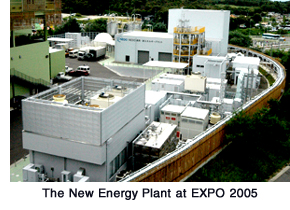 One way of generating and distributing electricity is through a concentrated power generation system - that is, to generate power at a large-scale power plant located in a remote area, and to transmit it through power lines to plants, office buildings and residential areas that are located far away. In the spotlight today, however, is the distributed energy system, a system based on the concept of setting up power generation equipment close to the site where the energy will actually be used. In other words, they place power generators adjacent to plants, office buildings, hospitals and other facilities to provide them with electrical power.
One way of generating and distributing electricity is through a concentrated power generation system - that is, to generate power at a large-scale power plant located in a remote area, and to transmit it through power lines to plants, office buildings and residential areas that are located far away. In the spotlight today, however, is the distributed energy system, a system based on the concept of setting up power generation equipment close to the site where the energy will actually be used. In other words, they place power generators adjacent to plants, office buildings, hospitals and other facilities to provide them with electrical power.The EXPO 2005 Aichi, Japan venue is acting as the site for a demonstration test of a globally unprecedented scale for such a distributed energy system that utilizes state-of-the-art alternative energy technology. |
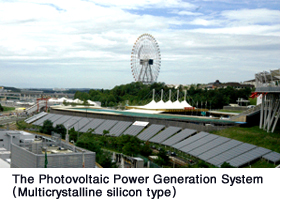 If you look around you from the vicinity of the Nagakute Area’s West Gate or from the Global Loop nearby Global Common 5, you will see several different types of solar panels. Also situated just north of Global Common 5 is the New Energy Plant, which may seem at first sight to be a chemical plant. They have all been installed by Japan’s New Energy and Industrial Technology Development Organization (NEDO) in collaboration with the Japan Association for the 2005 World Exposition, Aichi Prefecture and seven private companies, as part of the Demonstrative Project of Regional Power Grid with Various New Energies. The maximum total power output through this new energy system is 2,200kW, enough electricity to power about 870 households. It supplies all the energy used at Japan Pavilion Nagakute and the NEDO Pavilion.
If you look around you from the vicinity of the Nagakute Area’s West Gate or from the Global Loop nearby Global Common 5, you will see several different types of solar panels. Also situated just north of Global Common 5 is the New Energy Plant, which may seem at first sight to be a chemical plant. They have all been installed by Japan’s New Energy and Industrial Technology Development Organization (NEDO) in collaboration with the Japan Association for the 2005 World Exposition, Aichi Prefecture and seven private companies, as part of the Demonstrative Project of Regional Power Grid with Various New Energies. The maximum total power output through this new energy system is 2,200kW, enough electricity to power about 870 households. It supplies all the energy used at Japan Pavilion Nagakute and the NEDO Pavilion. |
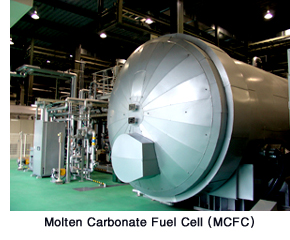 The New Energy System of the Demonstrative Project of Regional Power Grid with Various New Energies is a combination of photovoltaic power generation (solar power), fuel cells and Sodium-sulfur (NaS) batteries.
The New Energy System of the Demonstrative Project of Regional Power Grid with Various New Energies is a combination of photovoltaic power generation (solar power), fuel cells and Sodium-sulfur (NaS) batteries.The principle of fuel cells is based on the generation of electricity (and water) through a chemical reaction between oxygen and hydrogen. They are fueled by such items as fermented methane gas generated from organic waste of restaurants, etc. at the venue, as well as gasses produced through high-temperature gasification of wood waste from the construction of the EXPO site and the EXPO's waste plastic, including PET bottles. Organic waste and PET bottles are transported to the chemical-plant-like facilities every day and converted into biogas, which fuels fuel cells through methane fermentation and high-temperature gasification systems. Hydrogen is then extracted from the biogas and used to generate electricity through a chemical reaction. The exhaust heat that arises through the power generation process is also recovered and effectively reused to cool pavilion interiors after going through chillers. Meanwhile, the NaS battery is a battery that can store and discharge electricity. It has a high energy density that operates at a high temperature of 360 degrees Celsius. At EXPO 2005, NaS batteries that can operate for up to seven hours and discharge 500kW of electricity are used to regulate fluctuations in the electricity generated through solar power, or to store the excess electricity generated by fuel cells at night. As can be seen, the new energy system of the Demonstrative Project of Regional Power Grid with Various New Energies is controlled through a micro-grid energy control system (distributed power supply management system) to regulate the fluctuations in the electricity generated by solar energy and gasses of differing origins and efficiently provide stable power to Japan Pavilion Nagakute and the NEDO Pavilion. The carbon dioxide emitted by this new energy system is approximately 820 tons less per year than thermal power plants. Also, while the energy efficiency of thermal power plants is 40% with the remaining 60% wasted as exhaust heat and so on, the new energy system uses not only the generated electricity but also the exhaust heat without waste, and energy efficiency is said to be boosted to 80%. The reuse of organic waste and PET bottles and other plastic waste generated at the EXPO 2005 venue makes the new energy system a model system for eco-communities. The Tour of Energy Sources of the Future is offered by the NEDO Pavilion. This well-received tour enables visitors to experience cutting-edge new technology and enhance their understanding of new energies that utilize the power of nature. |
| EXPO 2005 AICHI, JAPAN Newsletter | |
| To read past issues:Back Number | |
| Editor/Publisher: Japan Association for
the 2005 World Exposition Head Office: 1533-1 Ibaragabasama, Nagakute-cho Aichi 480-1101 Japan Nagoya Office: Nagoya Daiya II Bldg 4F, 3-15-1 Meieki Nakamura-ku, Nagoya, Aichi 450-0002 Japan Tokyo Office: Iino Bldg 8F, 2-1-1 Uchisaiwai-cho Chiyoda-ku, Tokyo 100-0011 Japan |
 |
© Japan Association for the 2005 World Exposition
